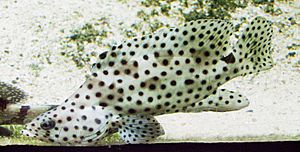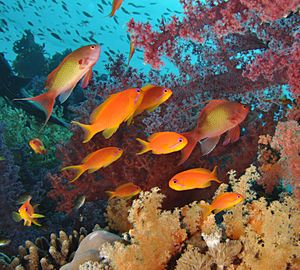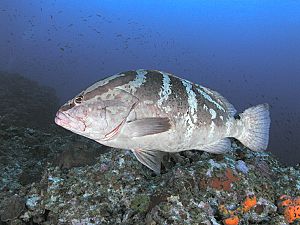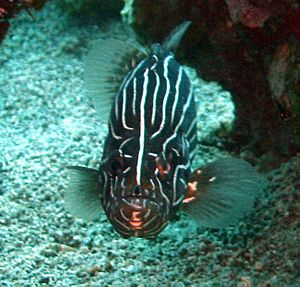Serranidae facts for kids
Quick facts for kids Serranidae |
|
|---|---|
 |
|
| Humpback grouper, Cromileptes altivelis | |
| Scientific classification |
|
| Kingdom: | Animalia |
| Phylum: | Chordata |
| Class: | Actinopterygii |
| Order: | Perciformes |
| Superfamily: | Percoidea |
| Family: | Serranidae Swainson, 1839 |
| Subfamilies | |
|
see text |
|
| Synonyms | |
|
Grammistidae Bleeker, 1857 |
|
The Serranidae are a large family of fishes belonging to the order Perciformes. The family contains about 450 species in 65 genera, including the sea basses and the groupers (subfamily Epinephelinae). Although many species are small, in some cases less than 10 cm (3.9 in), the giant grouper (Epinephelus lanceolatus) is one of the largest bony fishes in the world, growing to 2.7 m (8 ft 10 in) in length and 400 kg (880 lb) in weight. Representatives of this group live in tropical and subtropical seas worldwide.
Characteristics
Many serranid species are brightly colored, and many of the larger species are caught commercially for food. They are usually found over reefs, in tropical to subtropical waters along the coasts. Serranids are generally robust in form, with large mouths and small spines on the gill coverings. They typically have several rows of sharp teeth, usually with a pair of particularly large, canine-like teeth projecting from the lower jaw.
All serranids are carnivorous. Although some species, especially in the Anthiadinae subfamily, only feed on zooplankton, the majority feed on fish and crustaceans. They are typically ambush predators, hiding in cover on the reef and darting out to grab passing prey. Their bright colours are most likely a form of disruptive camouflage, similar to the stripes of a tiger.
Many species are protogynous hermaphrodites, meaning they start out as females and change sex to male later in life. They produce large quantities of eggs and their larvae are planktonic, generally at the mercy of ocean currents until they are ready to settle into adult populations.
Like other fish, serranids harbour parasites, including nematodes, cestodes, digeneans, monogeneans, isopods, and copepods. A study conducted in New Caledonia has shown that coral reef-associated serranids harbour about 10 species of parasites per fish species.
Classification


Recent molecular classifications challenge the validity of the genera Cromileptes (sometimes spelled Chromileptes) and Anyperodon. Each of these two genera has a single species, which were included in the same clade as species of Epinephelus in a study based on five different genes.
The subfamilies and genera are as follows:
- Subfamily Anthiinae Poey, 1861
- Acanthistius Gill, 1862
- Anatolanthias Anderson, Parin & Randall, 1990
- Anthias Bloch, 1792
- Baldwinella Anderson & Heemstra, 2012
- Caesioperca Castelnau, 1872
- Caprodon Temminck & Schlegel, 1843
- Choranthias Anderson & Heemstra, 2012
- Dactylanthias Bleeker, 1871
- Epinephelides Ogilby, 1899
- Giganthias Katayama, 1954
- Hemanthias Steindachner, 1875
- Holanthias Günther 1868
- Hypoplectrodes Gill, 1862
- Lepidoperca Regan, 1914
- Luzonichthys Herre, 1936
- Meganthias Randall & Heemstra, 2006
- Nemanthias J.L.B. Smith, 1954
- Odontanthias Bleeker, 1873
- Othos Castelnau, 1875
- Plectranthias Bleeker, 1873
- Pronotogrammus Gill, 1863
- Pseudanthias Bleeker, 1871
- Rabaulichthys Allen, 1984
- Sacura D.S. Jordan & Richardson, 1910
- Selenanthias Tanaka, 1918
- Serranocirrhitus Watanabe, 1949
- Tosana H.M. Smith & Pope, 1906
- Tosanoides Kamohara, 1953
- Trachypoma Günther, 1859
- Subfamily Epinephelinae Bleeker, 1874 (groupers)
- Tribe Niphonini D.S. Jordan, 1923
- Niphon Cuvier, 1828
- Tribe Epinephilini Bleeker, 1874
- Aethaloperca Fowler, 1904
- Alphestes Bloch & Schneider, 1801
- Anyperodon Günther, 1859
- Cephalopholis Bloch & Schneider, 1801
- Chromileptes Swainson, 1839
- Dermatolepis Gill, 1861
- Epinephelus Bloch, 1793
- Gonioplectrus Gill, 1862
- Gracila Randall, 1964
- Hyporthodus Gill, 1861
- Mycteroperca Gill, 1862
- Paranthias Guichenot, 1868
- Plectropomus Pken, 1817
- Saloptia J.L.B. Smith, 1964
- Triso Randall, Johnson & Lowe, 1989
- Variola Swainson, 1839
- Tribe Diploprionini Bleeker, 1874
- Aulacocephalus Temminck & Schlegel, 1843
- Belonoperca Fowler & B.A. Bean, 1930
- Diploprion Cuvier, 1828
- Tribe Liopropomini Poey, 1867
- Bathyanthias Günther, 1880
- Liopropoma Gill, 1861
- Rainfordia McCulloch, 1923
- Tribe Grammistini Bleeker, 1857
- Aporops Schultz, 1943
- Grammistes Bloch & Schneider, 1801
- Grammistops Schultz 1953
- Jeboehlkia Robins, 1967
- Pogonoperca Günther 1859
- Pseudogramma Bleeker, 1875
- Rypticus Cuvier, 1829
- Suttonia J.L.B. Smith, 1953
- Tribe Niphonini D.S. Jordan, 1923
- Subfamily Serraninae Swainson, 1839
- Bullisichthys Rivas, 1971
- Centropristis Cuvier, 1829
- Chelidoperca Boulenger, 1895
- Cratinus Steindachner, 1878
- Diplectrum Holbrook, 1855
- Hypoplectrus Gill, 1861
- Paralabrax Girard, 1856
- Parasphyraenops T.H. Bean, 1912
- Schultzea Woods, 1958
- Serraniculus Ginsburg, 1952
- Serranus Cuvier, 1816
- incertae sedis
- Caesioscorpis Whitley, 1945
- Hemilutjanus Bleeker, 1876
- †Palaeoperca Micklich, 1978 (Eocene, Germany)
Timeline of genera

See also
 In Spanish: Serranidae para niños
In Spanish: Serranidae para niños


